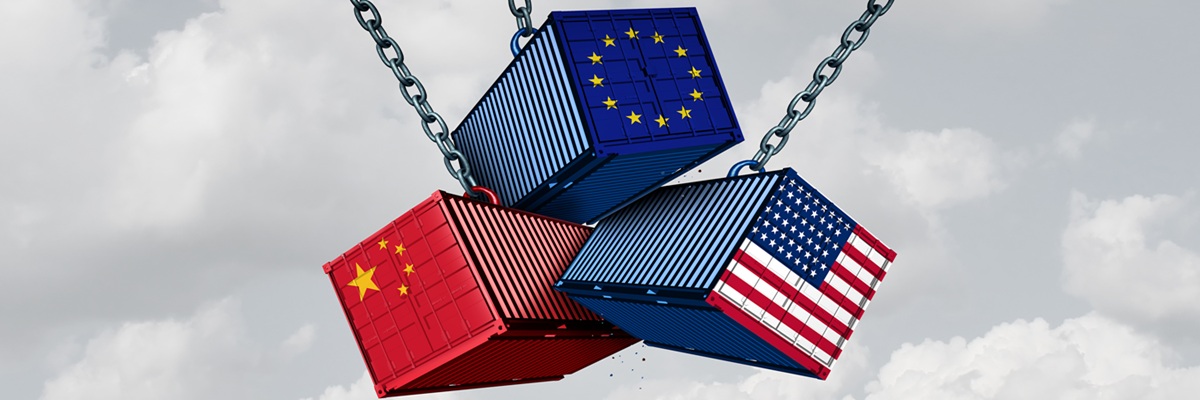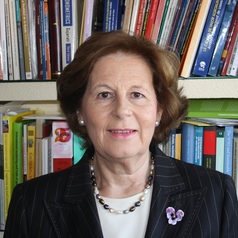Energy & Economics
Trump Doctrine: extreme protectionism against its commercial and technological rivals

Image Source : Shutterstock
Subscribe to our weekly newsletters for free
If you want to subscribe to World & New World Newsletter, please enter
your e-mail
Energy & Economics

Image Source : Shutterstock
First Published in: Feb.13,2025
Mar.04, 2025
The commitment to free trade is based on the competitive advantage that nations gain from possessing certain material and human resources that are scarce in other countries. The exchange of goods under the umbrella of free trade results in a global benefit, as it fosters economic growth, improves the quality of goods, and diversifies supply.
The free trade doctrine, which has governed international trade in recent decades, is opposed by protectionism, which seeks to favor domestic producers over foreign competition.
Above All, Protectionism
Trump's campaign to win votes from the U.S. automotive and agricultural sectors was based on extreme protectionism – which we could call the ‘Trump Doctrine’ – centered on the promise of raising tariffs on products from competing countries.
The increase in tariffs to boost domestic production in non-competitive sectors clashes with the rules of the World Trade Organization and the already established trade relations with exporting countries.
On the other hand, those who silently suffer from Trump's protectionist measures are American consumers, who will have to pay higher prices for imported products that are currently cheaper.
The need to reorganize international trade flows had already been raised due to the existence of ecological, social, or economic dumping. In response to violations of competition rules and the presence of discriminatory situations, agricultural groups have demanded mirror clauses to ensure that imported products comply with the same regulations as domestic ones. However, all these proposals have been made within a negotiating framework and not in a disruptive and unilateral manner, as the Trump Doctrine does.
Tariff Increases
Specifically, the U.S. has formalized a 25% tariff on steel and aluminum from other countries, set to take effect on March 4. This impacts the Spanish industrial sector, which exports aluminum worth 500 million to the U.S. market.
There are still no details on which Spanish agri-food products (such as wine, olive oil, meat, and dairy) may be affected and to what extent by the Trump Doctrine. Latin American countries are also at risk: in 2021, 86% of their agri-food exports were destined for three regions — the U.S. (23%), the EU (18%), and China (13%). The EU and Latin American countries belonging to Mercosur have the advantage of having signed an agreement in December 2024, which will allow them to strengthen their trade relations and potentially offset losses in the U.S. market.
In response to these tariff attacks, countries have reacted by attempting to reach agreements among the affected nations. The European Union and Canada have met to design a joint strategy against the Trump Doctrine, and China is also considering reorganizing its trade flows, which could provide some relief for its exports.
However, the damage caused by tariffs is global and does not only affect exporting countries. In the United States, there will be negative impacts on consumers and businesses in the form of higher prices and even shortages or the disappearance of some imported products.
United States-Europe Trade Relations
There is no free trade agreement between Europe and the United States, although an attempt was made, without success, to establish the Transatlantic Trade and Investment Partnership (TTIP). However, progress has been made in harmonizing food safety regulations, quality standards, and data privacy rules. Nevertheless, Trump accuses Europe of "treating the United States very badly" and has warned that they must balance the "$350 billion" trade deficit.
In Europe, the most exposed sectors to the threat of U.S. protectionism are aerospace, automotive, and agri-food. The countries at the highest risk include Germany (automotive), France (aerospace), the Netherlands (petrochemical), Italy (pharmaceutical), Ireland (technology), and Spain (agri-food), as they have the most open economies to foreign trade.
On the other hand, the United States exports high-tech products, machinery, chemicals, and agricultural goods (corn, soy, meat) to Europe. In the digital sector, major U.S. companies (Amazon, Google, Apple, Meta) are well-positioned in the Old Continent, often engaging in market dominance abuses that the EU has attempted to curb through fines and legislative changes.
Spanish exports to the United States focus on automobiles, machinery, and pharmaceutical and agri-food products (wine, olive oil, meat, dairy, and horticultural products). U.S. imports into the Spanish market primarily consist of machinery, electronic products, pharmaceuticals, financial services, and agricultural goods.
The U.S. has invested in Spain in the automotive, technology, energy, distribution, and finance sectors. In turn, Spain has a presence in the North American market in the distribution sector (Inditex, Mango), renewable energy (Iberdrola, Acciona, Naturgy), communications, and infrastructure (Ferrovial, ACS, Sacyr).
The Technological Battle
A fierce competition is emerging in the development of space travel, military technology, and integrated artificial intelligence. In the geopolitical landscape, development cooperation, armed conflicts, climate change, and environmental sustainability are key issues to consider.
We have just witnessed how restrictions on the supply of microprocessors stimulated China's creativity in the tech sector. China welcomed the new year with DeepSeek, its own AI model — with similar capabilities to ChatGPT but significantly lower costs — which has shaken the U.S. tech industry and triggered a stock market upheaval.
Meanwhile, the EU is now trying to shake off its role as a mere spectator in the development of these new technologies and has just announced a €200 billion investment in the development of European AI. It is important to remember that Europe has been a pioneer in AI legislation, with the Artificial Intelligence Act approved by its Parliament at the end of 2023.
Outlook and Solutions
The impact of trade wars depends, on one hand, on the measures imposed (tariff, fiscal, or regulatory) and the volume of existing trade flows. However, the characteristics of the regions, economic sectors, and affected social groups also play a crucial role.
In the final countdown, before the implementation of the new tariffs, the United States reached a preliminary agreement with Mexico and Canada, granting a one-month pause before enforcing the announced tariffs. In the case of China, its response to the U.S. threat was to announce similar tariff increases on American products.
Among European countries, there are different strategic approaches to the Trump Doctrine. The positions of the Paris-Berlin axis — ready to respond to U.S. tariff threats — and the Rome-Budapest axis are opposed. It remains to be seen whether Italian Prime Minister Giorgia Meloni, who attended Trump's inauguration on January 20, will act as a mediator between the EU and the U.S. or if she will focus solely on securing a favorable position for Italy.
Volatility, Uncertainty, Fluctuations
A trade war affects foreign investments and creates volatility in financial markets due to the uncertainty it generates. Additionally, it reduces trade exchanges (imports-exports) and causes fluctuations in currency markets. The dilemma of “restructuring or rejection” posed by the Trump Doctrine involves the option of readjusting the existing order or entering into direct competition.
For now, tensions remain high, and The Wall Street Journal, one of the major U.S. media outlets, describes the trade war as “absurd,” “unnecessary,” and “stupid.”
The reality is that an atmosphere of international insecurity has been created regarding future investments, and stock markets have suffered losses. Meanwhile, the threatened countries insist they will enforce countermeasures, to which Trump responds by threatening to raise tariffs even further.
First published in :

Professor and Doctor in the field of Applied Economics at the University of Castilla-La Mancha. She has participated as a speaker in numerous national and international conferences (Italy, Portugal, the United Kingdom, etc.).
She has over thirty publications, including articles in some of the highest-impact international journals, several book chapters, and three monographs.
Her research areas focus on cultural tourism management, specifically archaeological tourism, and quantitative methods in economics.

Isabel de Felipe Boente holds a Ph.D. in Economic Sciences and has been an Associate Professor at the Polytechnic University of Madrid. She is a member of the Steering Council of itdUPM (Innovation Center in Technology for Human Development) and serves on the Board of Directors of PRONATUR.
She has collaborated on EU research projects and development cooperation initiatives. Additionally, she is the author of articles and books on urban greening.

Doctor of Agricultural Engineering
Master's in Agricultural Economics, University of Minnesota, USA
Founder and President of PRONATUR
Member of the French Academy of Agriculture
Board Member of the World Green Infrastructure Network and the European Federation of Green Infrastructure (EFB)
Author of national and international books and articles.

Graduated in Geography and History, specializing in Archaeology from the University of Valencia, and International PhD from the University of Castilla-La Mancha, his doctoral thesis was awarded the Extraordinary Doctorate Prize.
He has an extensive teaching career, having taught at the Alfonso X el Sabio University and later at the Associated Center of UNED in Cuenca. Currently, he is an Associate Professor of Archaeology and Ancient History at UCLM. Additionally, he teaches in several university master's programs, including international ones.
His academic management experience includes serving as Director of the Associated Center of UNED in Cuenca.
He has participated in numerous R&D&I projects funded through public regional, national, and international grants. The results of his research have been published in over 160 works, including monographs, articles in national and international journals, and book chapters.
Furthermore, he has led and coordinated numerous seminars, courses, and exhibitions, as well as participated in multiple conferences.
He is a Full Member of the Royal Academy of Arts and Letters of Cuenca.
Beyond his academic work, he plays a key role in team management, both scientifically and organizationally. His expertise is evident in his work as the lead coordinator of technical and human teams to ensure high-quality scientific research in various fields. Notably, he has directed numerous archaeological excavations across Spain, including significant sites such as the Iberian necropolises of Iniesta, the Roman city of Ercávica, the Roman villa of Noheda, and the multi-phase site of La Cava.
In addition, he has coordinated over thirty projects related to the enhancement of archaeological heritage as a tourism and cultural resource, receiving several awards, including recognition for the "Actuamos en Patrimonio" (We Act in Heritage) program.
Unlock articles by signing up or logging in.
Become a member for unrestricted reading!